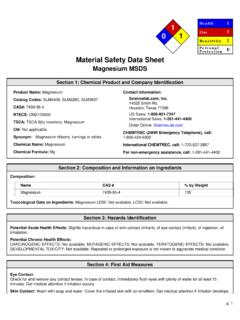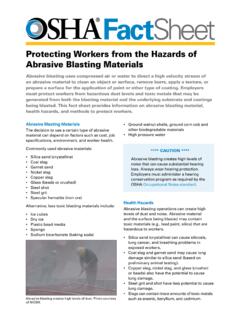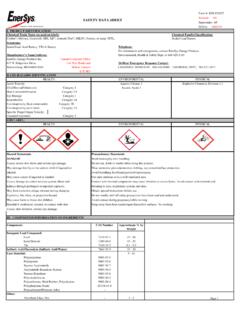Transcription of Cadmium for PDF - Occupational Safety and Health ...
1 Cadmium OSHA 3136-06R 2004 OccupationalSafety and informational booklet provides a general overview of a particular topic related to OSHA standards. It does not alteror determine compliance responsibilities inOSHA standards or the Occupational Safetyand Health Act of 1970. Because interpreta-tions and enforcement policy may changeover time, you should consult current OSHA administrative interpretations and decisionsby the Occupational Safety and HealthReview Commission and the Courts for additional guidance on OSHA publication is in the public domain and may be reproduced, fully or partially,without permission. Source credit is requested but not information is available to sensoryimpaired individuals upon phone: (202) 693-1999; teletypewriter(TTY) number: (877) s role is to assure the Safety andhealth of America s workers by setting andenforcing standards; providing training,outreach, and education; establishing partnerships.
2 And encouraging continualimprovement in workplace Safety Department of LaborOccupational Safety and Health AdministrationOSHA 3136-06R2004 Cadmium OSHA protects workers exposed to limits for action Cadmium hazards to Requirements for air monitoring for employees of monitoring for a compliance for protective cleaning requirements for protective of for medical 1: Respiratory Protection for periodic medical to and protection of medical created through to remove an employee from monitoring surveillance and Health program management Protection Programs (VPP)..23 Strategic Partnership training and available Regional , a naturally occurring element found in the earth scrust, was discovered in 1817, but was not used commercially untilthe end of the 19th century.
3 This soft, silver-white metal was firstused in paint pigments and as a substitute for tin in World War , about three-fourths of Cadmium is used as an electrodecomponent in alkaline batteries, with the remainder used inpigments, coatings, and platings and as a stabilizer for plastics. Workers in many industries face potential exposure to potential for exposure is highest among workers in electroplat-ing, metal machining, plastics, ceramics, paint, and weldingoperations. The main exposure routes are through inhalation ofdust and fumes and the incidental ingestion of dust from contami-nated hands, food, or may also be exposed to Cadmium from the smeltingand refining of metals or from air in industrial plants thatmanufacture batteries, coatings, or plastics. The Agency for ToxicSubstances and Disease Registry estimates that more than 500,000workers in the United States face exposure to Cadmium each year.
4 How OSHA protects workers exposed to cadmiumThe primary and most serious adverse Health effects of long-term exposure to Cadmium include kidney dysfunction, lung cancer,and prostate cancer. Cadmium may cause local skin or eyeirritation and can affect long-term Health if inhaled or face a greater danger of Cadmium exposure frominhalation than from ingestion. Exposure to Cadmium that may bedangerous to life or Health may occur in jobs in which workers areexposed to Cadmium dust or fumes, where they heat compoundsor surfaces that contain Cadmium , or where workers weld or cutwith materials or solders that contain moved to protect workers exposed to Cadmium more than30 years ago when it adopted the American National StandardsInstitute s (ANSI) threshold limit values (TLVs) for Cadmium as anational consensus standard under the authority of the OccupationalSafety and Health Act of 1970, Section 6(a) in 1971.
5 In 1992, OSHA reduced the exposure limits after a quantitative risk assessment and3a long-term evaluation of epidemiological studies of lung cancer andrenal dysfunction among workers and animal studies. The revisedexposure limits were published in the Federal Register (Title 29 CFR,Part ) and took effect on December 14, full OSHA standard relating to Cadmium (applicable togeneral industry, agriculture, and maritime) is found at 29 This booklet should not be used as a substitute for thefull regulatory requirements of the Cadmium standard. The con-struction industry has a separate Cadmium standard, found in 29 CFR limits for cadmiumThere are three exposure limits an employer must observeunder the OSHA Cadmium standard. The first is the action level, orAL, which is defined as the airborne level of Cadmium that creates aneed for airborne exposure monitoring, a medical surveillanceprogram for employees who are at or above the AL on 30 or moredays per year, and the provision of a respirator to any employeethat requests one.
6 The second limit is the Permissible ExposureLimit, or PEL, which defines the limit to which an employee may beexposed to Cadmium in the workplace. The third limit level isknown as a Separate Engineering Control Air Limit, or SECAL, andmay be one of several specific and unique exposure limits thatapply to select and defined industries and processes. The employermust achieve the PEL through engineering controls and workpractices in all industries not designated with a separate action levelThe action level for workplace exposure to Cadmium is per cubic meter of air ( g/m3) calculated as an 8-hour time-weighted average (TWA) PELThe PEL is a time-weighted average concentration that must notbe exceeded during any 8-hour work shift of a 40-hour work standard sets a PEL of 5 micrograms of Cadmium per cubicmeter of air (5 g/m3) for all Cadmium compounds, dust, and SECALsThe SECAL is a separate exposure limit to be achieved inspecified processes and workplaces where it is not possible toachieve the PEL of 5 g/m3through engineering and work practicesalone.
7 The SECAL for Cadmium is 15 g/m3or 50 g/m3,depending on the processes involved. The employer covered bythe SECAL is required to achieve that limit by engineering and workpractice controls to the extent feasible and to protect employeesfrom exposures above the PEL by any combination of compliancemethods, including engineering and work practice controls industries that have separate SECALs identified for specificprocesses include nickel Cadmium battery production, zinc/ Cadmium refining, pigment and stabilizer manufacturing, leadsmelting, and SECAL is set at 50 g/m3for the following industries andprocesses: Nickel Cadmium battery industryPlate making, plate preparation process Zinc/ Cadmium refiningCadmium refining, casting melting, oxide production, sinter plant Pigment manufacturingCalcine, crushing, milling, and blending Stabilizer productionCadmium oxide charging, crushing, drying, and blending Lead smeltingSinter plant, blast furnace, baghouse, and yard areaThe SECAL is set at 15 g/m3for the following industries andprocesses: Nickel Cadmium battery industryAll processes not identified above Pigment manufacturingAll processes not identified above Plating manufacturingMechanical plating5 Communicating Cadmium hazards to employeesEmployees must be made aware of the dangers associatedwith exposure to Cadmium in the workplace.
8 The employer must comply with the requirements of the OSHA HazardCommunication Standard (29 CFR ), including theplacement of warning signs and labels in visible locations, accessto material Safety data sheets (MSDS), and providing appropriateemployee signs must be displayed in regulated areas and in allapproaches to regulated areas. (A regulated area is defined as the area in which an employee may face exposure to Cadmium atlevels above the PEL.) The signs must be illuminated, cleaned, andmaintained so that the legend is readily visible, and they mustinclude the following words: Danger Cadmium Cancer hazard Can cause lung and kidney disease Authorized personnel only Respirators required in this areaShipping and storage containers that contain Cadmium , Cadmium compounds, or Cadmium -contaminated clothing,equipment, waste, scrap, or debris must be labeled with thefollowing information.
9 Danger Contains Cadmium Cancer hazard Avoid creating dust Can cause lung and kidney diseaseInstalled Cadmium products must have a visible label or otherindication that Cadmium is present, where trainingEmployees must receive training prior to or at the time of theirinitial assignment to a position that involves potential exposure tocadmium and at least annually thereafter. Required trainingelements include: Explanation of the Health hazards associated with Cadmium exposure (See Appendix A of the Cadmium standard at 29 CFR ). Information about where and how Cadmium is used, stored, andreleased at the worksite, including processes or operations that involve potential Cadmium exposure, especially above the PEL. Explanation of engineering controls and work practices for the employee s job assignment to control exposure to Cadmium associated with the employee s job assignment.
10 Description of measures employees can take to protect themselves from Cadmium exposure, such as modification of smoking, personal hygiene precautions, and appropriate work practices. Explanation of emergency procedures. Information on the purpose, selection, fitting, use, and limitations of personal protective equipment. Explanation of the medical surveillance program. Make a copy of the Cadmium standard and its appendices readily available and provide employees with a copy of the standard if requested. Informing employees of their rights of access to employer must ensure that employees understand that theyare prohibited from eating, drinking, smoking, chewing tobacco orgum, or applying cosmetics of any kind in regulated areas. Thisalso includes a prohibition on carrying or storing these materials oritems in a regulated employer must make information about the companytraining program available to the Assistant Secretary of Labor forOccupational Safety and Health or the Director of the NationalInstitute for Occupational Safety and Health upon for air monitoring for cadmiumIf your business or workplace has the potential to exposeemployees to Cadmium , the first step is to determine whether thatexposure will be at or above the action level of g/m3.















